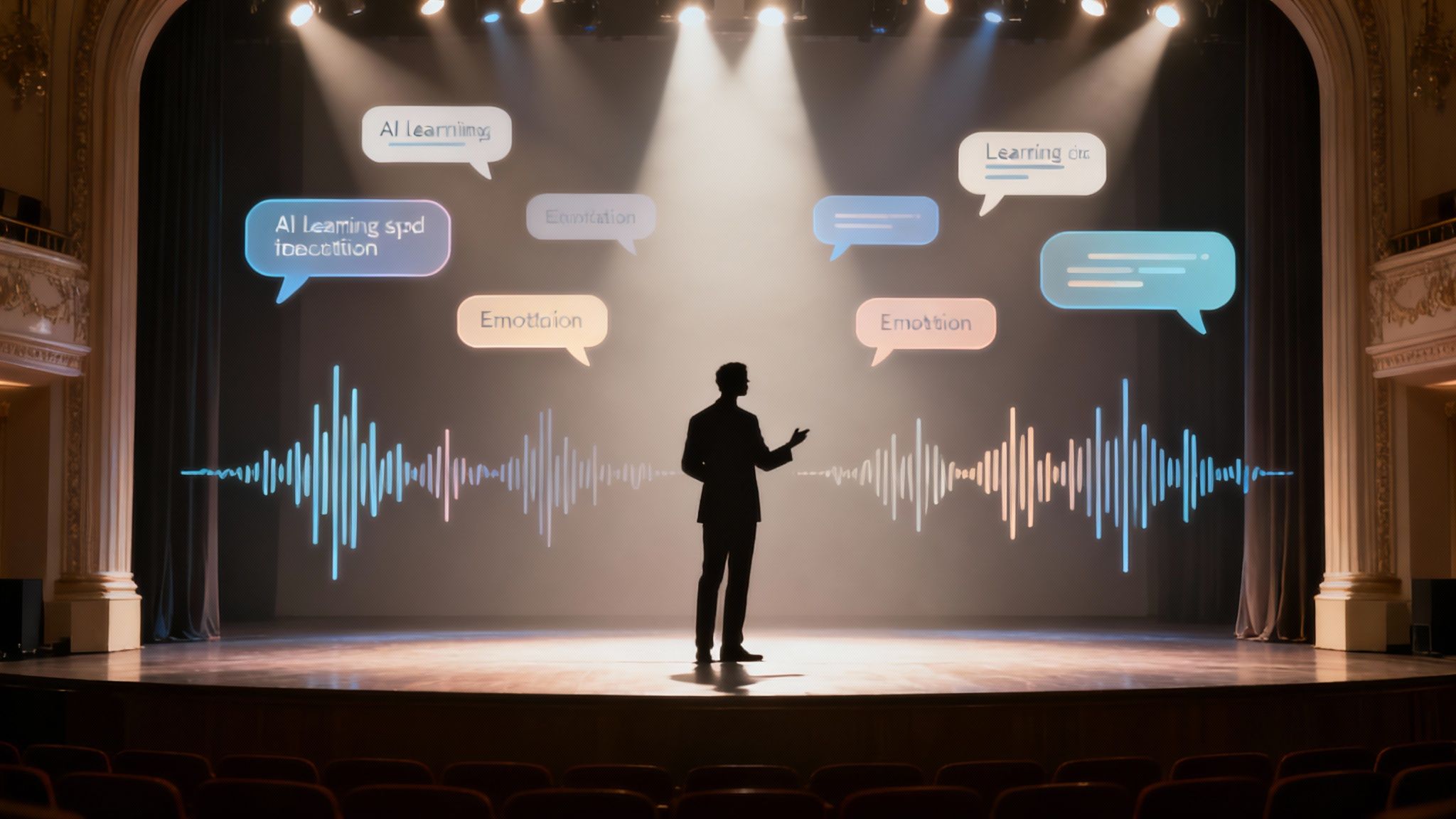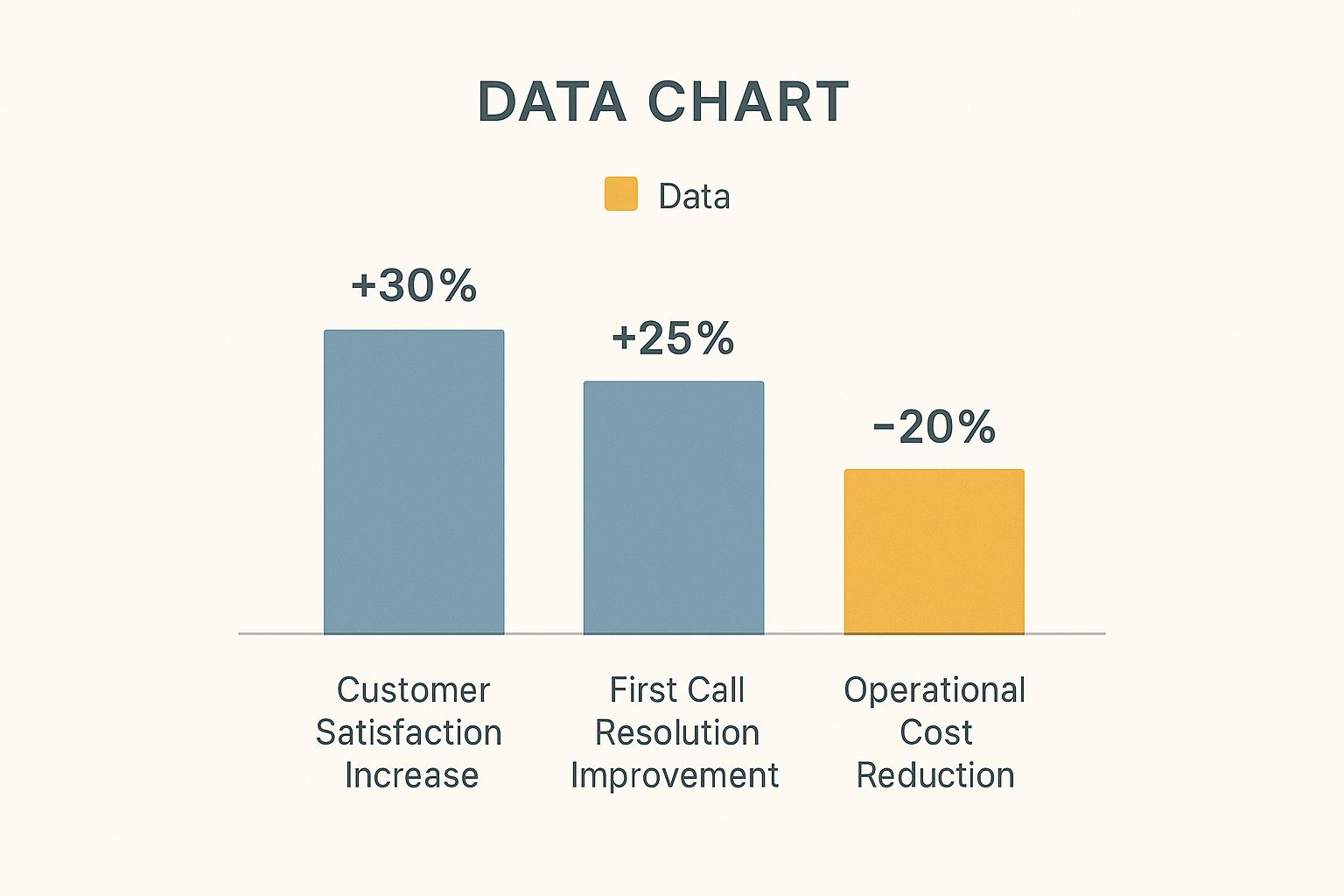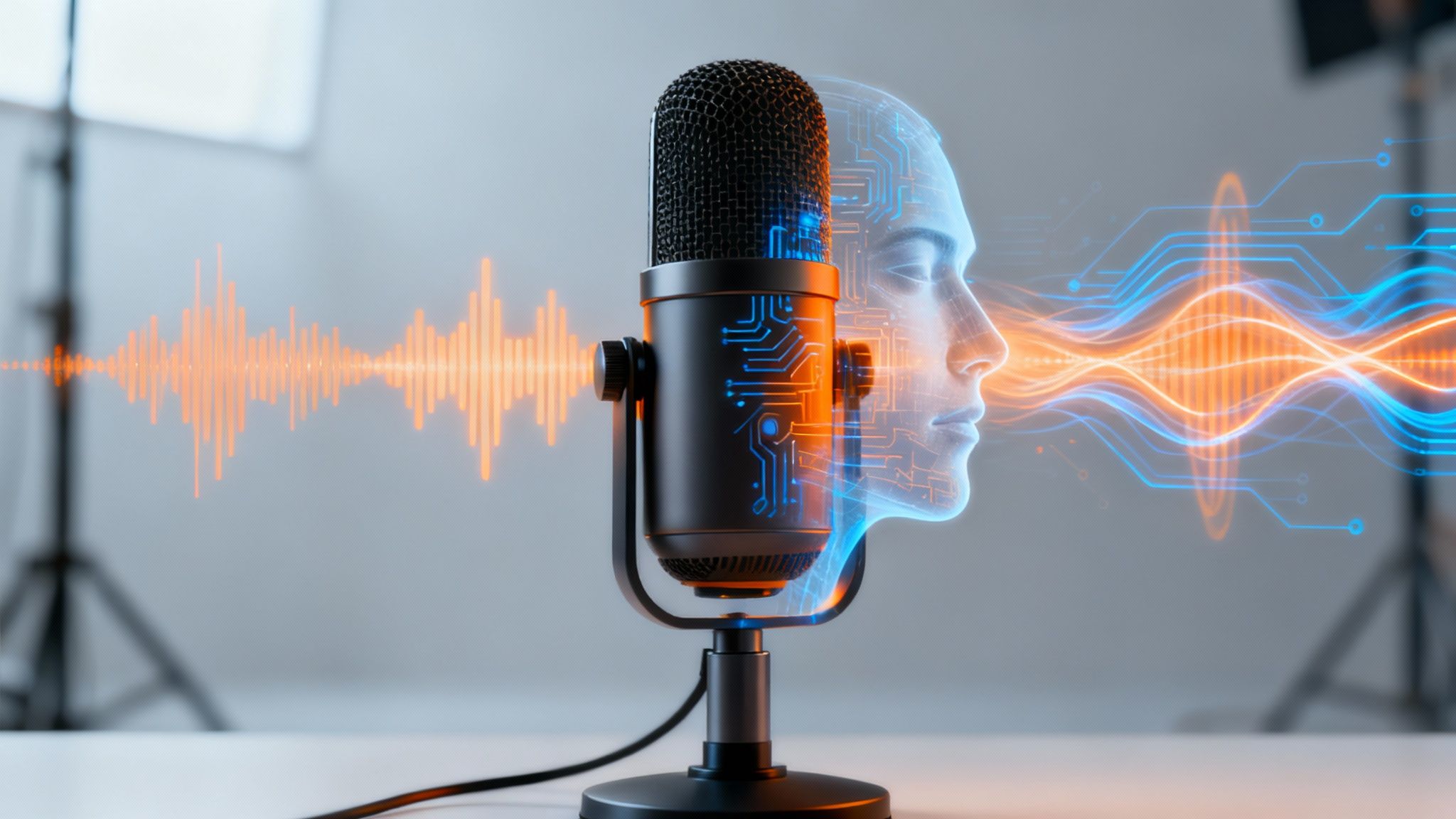Remember the days of calling a company and getting stuck with a clunky, robotic voice? You’d find yourself slowly repeating keywords, just hoping the system would understand, only to hear, "I'm sorry, I didn't get that." Thankfully, that frustrating experience is becoming a thing of the past.
AI voice agents that actually sound human aren't just a cool idea from a sci-fi movie anymore; they're powerful tools that are completely changing how businesses talk to their customers. These systems are designed to have natural, flowing conversations, leaving the old robotic menus in the dust. For businesses, this means you can offer 24/7 support that feels genuinely personal and helpful.
The New Voice of Modern Business

The technology has taken a massive leap forward. Think of it like the difference between old-school, blocky computer graphics and the stunning CGI you see in movies today—it’s often so realistic you can't tell it apart from the real thing. That's where we are now with AI voice agents. They're the CGI of customer service, built to be so intuitive that your customers often won't even realise they're speaking to an AI.
Why a Human Touch Matters in AI
This isn't just about fancy new tech; it's a fundamental shift in customer interaction. A voice that sounds human builds trust, cuts down on frustration, and creates a much more positive feeling about your brand. When a customer feels like they're being properly heard and understood, their loyalty deepens.
That 'human touch' has gone from a nice-to-have luxury to an absolute must for any business looking to scale its customer experience.
This guide will walk you through the world of ai voice agents that sound human, breaking down everything you need to know:
- The Core Technology: We’ll look at how AI actually learns to speak with natural pacing, tone, and even emotion.
- Real-World Impact: What are the real, tangible benefits for businesses? Think better efficiency and happier customers.
- Practical Applications: We'll explore how companies are already using these agents to solve everyday problems.
- Your Next Steps: How you can get started with this technology, including options like a dedicated AI answering service for your business.
By the end of this guide, you won't just know what these advanced voice agents are. You'll understand how they can become a game-changing asset for your own operations, making sure every customer interaction is a great one.
How AI Learns to Speak Like a Person

Creating AI voice agents that sound human is a lot like training a world-class actor. It’s not enough to just read lines from a script; they need to get the meaning, emotion, and rhythm behind the words. Early text-to-speech (TTS) systems were like a nervous actor at their first read-through—stiff, robotic, and just trying to pronounce each word correctly.
Today’s AI has moved way beyond that. It now combines a few powerful technologies to deliver a performance that feels genuine. Instead of just speaking at you, they have a proper conversation with you.
The Three Pillars of a Human-Like Voice
The magic behind a truly natural-sounding AI voice rests on three core bits of tech working together perfectly. Each one has a specific job in turning plain text into a rich, conversational experience that actually connects with the listener.
- Text-to-Speech (TTS) Synthesis: This is the foundation. It’s the part that turns written words into audible speech. Modern TTS uses deep learning to chew through massive datasets of human speech, figuring out not just pronunciation but all the subtle things that make a voice sound real.
- Natural Language Processing (NLP): Think of NLP as the AI's "brain." This is what allows the agent to understand the meaning and intent behind what someone’s saying, not just the words themselves. It’s absolutely vital for getting the context right and coming up with a smart response.
- Generative AI: This is where the creativity comes in. Generative AI models create new, original responses on the fly, making chats feel dynamic and unscripted. Instead of just picking from a list of pre-written answers, the AI can craft unique replies that fit the flow of the conversation.
This combo of technologies is really changing how people see and use AI. You can see it in the growing confidence Australians have in AI. A recent Google survey found that 52% of Australians believe AI will benefit them personally. This kind of optimism is fuelled by the increasingly human-like experiences AI can deliver. You can read more about the findings on AI adoption in Australia if you're curious.
Mastering the Art of Conversation
Just speaking clearly isn't enough to sound human. The real trick is mastering prosody—the rhythm, stress, and intonation of speech. It's the difference between a flat, boring statement and a warm, engaging question.
Prosody is the music of language. It’s how we show emotion, ask questions, and add emphasis. An AI that nails prosody can express empathy, urgency, or friendliness, making the whole interaction feel far more personal.
AI models learn this "music" by studying thousands of hours of human conversations. They pick up on patterns, like the slight upward lift at the end of a question or the gentle pause someone uses for emphasis. This allows the AI to generate speech that doesn't just sound correct, but feels emotionally right for the moment.
For a deeper dive into how artificial intelligence is refined to create content that sounds genuinely human, it's worth checking out resources on how to humanize AI text.
Ultimately, all these pieces come together to create a seamless conversational partner. The NLP engine understands your question, the generative AI figures out a thoughtful response, and the advanced TTS system delivers it with the warmth and nuance of a real person. This complex dance is what separates a basic chatbot from a truly helpful, human-sounding AI voice agent.
The Business Impact of Lifelike AI Voices
It's one thing to get your head around the tech behind AI voice agents that sound human, but seeing the real-world impact they have on a business is where it really clicks. When you move past the technical jargon, the benefits show up in tangible improvements to customer experience and how smoothly your operations run. When a customer hears a voice that’s natural and empathetic, it completely changes the feel of the conversation.
This isn't just a small tweak; it's a fundamental shift. Frustration melts away when callers aren't wrestling with a clunky, robotic menu. Instead, they feel heard and understood, which is a massive step towards building trust and strengthening their connection to your brand.
Boosting Customer Experience and Loyalty
A lifelike AI voice agent is your tireless, high-quality support specialist, always on deck. Human teams need breaks and work in shifts, but an AI is ready to go 24/7 to answer questions, sort out issues, or process requests. This means your customers get help the second they need it, not just during business hours.
That immediate support is a game-changer. A recent study found that 66% of customers believe the most important thing a company can do is value their time. AI voice agents hit this nail on the head by wiping out long queues and giving instant answers, showing customers you respect their time.
They can also deliver personalised service on a massive scale. By plugging into your CRM, an AI can greet a customer by name, mention their recent order, and even guess what they might need next. That kind of attention makes people feel valued, turning a routine support call into a genuinely positive brand moment.
By providing empathetic, instant, and personalised support, human-sounding AI voice agents don't just solve problems—they build brand loyalty. Every positive interaction reinforces a customer's decision to do business with you.
Achieving Major Operational Wins
While a better customer experience is a huge victory, the benefits on the operational side are just as powerful. Putting AI voice agents to work means you can automate a huge chunk of routine calls. This frees up your human agents to tackle the more complex, high-value, or emotionally charged situations where they can really shine.
The financial upside is pretty significant. Automating calls—both inbound and outbound—slashes the cost per interaction and lightens the load on your team. You can scale up your support without having to scale up your headcount at the same rate.
This infographic breaks down the typical performance boosts businesses see after bringing in advanced voice AI.

The numbers speak for themselves, showing real results across customer happiness, problem-solving, and cost savings.
To get a clearer picture of the difference between old-school automated systems and modern AI, have a look at this comparison.
Business Impact of Human-Like vs. Robotic AI Voice Agents
| Business Metric | Robotic IVR System | Human-Like AI Voice Agent |
|---|---|---|
| Customer Satisfaction | Often low due to frustrating menus and unnatural interactions. | Significantly higher, with customers feeling understood and valued. |
| First Call Resolution | Limited to simple, pre-programmed tasks. | A 25% improvement as AI resolves complex queries with data access. |
| Operational Costs | Lower than human agents but with limited capabilities. | A 20% reduction through automation of high-volume calls. |
| Agent Burnout | No direct impact, but call volume remains high for agents. | Reduced, as agents focus on meaningful, complex work. |
| Brand Perception | Can be perceived as dated, impersonal, and inefficient. | Seen as modern, innovative, and customer-focused. |
It's clear that the leap from a robotic system to a human-like one isn't just cosmetic—it delivers fundamentally better business outcomes across the board.
Let’s dig into some of the most common operational improvements:
- First Call Resolution (FCR): With instant access to knowledge bases and customer data, AI agents often solve issues on the first try. A higher FCR means happier customers and a more efficient contact centre.
- Reduced Agent Burnout: By handling the repetitive, predictable queries, AI takes the grind out of the job for human agents. They get to focus on more rewarding work, which boosts job satisfaction and helps keep your best people around.
- Data-Driven Insights: Every conversation an AI has is a goldmine of data. You can analyse call transcripts to spot common customer frustrations, new trends, or ways to improve your products. Your contact centre shifts from being a cost centre to a source of sharp business intelligence.
An AI agent doesn't just answer the phone; it becomes a core part of your operational strategy. To see how this works in practice, you can explore the capabilities of modern AI phone agents and see how they’re built for business.
Ultimately, the impact is undeniable. Lifelike AI voices create a powerful combination of happier customers and leaner, more effective operations. They let you deliver a top-notch experience while driving down costs and empowering your human team to do their best work.
AI Voice Agents in Action Across Industries

The theory behind AI voice agents that sound human is one thing, but their real value shines when you see them solving actual problems. Across Australia, businesses are putting this tech to work, turning routine tasks into smooth, positive experiences for their customers.
From bustling online stores to busy clinics and financial firms, these AI agents are so much more than glorified answering machines. Think of them as capable, intelligent extensions of your team, handling crucial interactions with precision and a natural, conversational touch.
The shift is happening fast. As of 2025, research shows that one in three Australians are regular users of AI assistants. That’s a massive jump of 7% since March of the same year, highlighting just how much we're leaning on AI for everything from shopping to planning. You can get more insights into the growing Australian appetite for agentic AI here.
Let's dive into how a few key Australian industries are cashing in.
Powering Modern Retail and E-commerce
In the cut-throat world of retail, customer experience is king. Shoppers want instant answers, whether they’re chasing an order or asking about a product. This is where human-sounding AI voice agents really come into their own.
Imagine a customer calling after hours to ask, "Where's my order?" Instead of a generic voicemail, a friendly AI agent greets them by name, pulls up their order using their phone number, and gives them a real-time shipping update. Simple.
- The Problem: An endless stream of repetitive questions about order status, stock levels, and return policies, which ties up your human support staff.
- The AI Fix: An AI voice agent hooks into e-commerce platforms like Shopify or Magento to provide instant, accurate answers 24/7. It can even offer personalised product recommendations based on what a customer has bought before.
- The Payoff: Customers get the help they need immediately, which keeps them happy. Your team, meanwhile, is freed up to tackle more complex sales or support issues, making the whole operation more efficient.
Enhancing Patient Communication in Healthcare
Healthcare administration is a constant juggle of calls for appointments, prescription refills, and pre-visit questions. A human-like AI voice agent can manage these tasks with the empathy and clarity patients need.
Picture this: a busy parent calls their local clinic at 10 PM to reschedule their child's appointment. The AI agent checks the clinic's calendar, finds an open slot, books the new time, and pings over a confirmation SMS—all within a single, natural conversation.
This level of accessibility doesn't just improve the patient experience; it dramatically cuts down the admin load on front-desk staff, letting them focus on the people right in front of them.
The tech is versatile, too. It can even handle sophisticated tasks like real-time AI audio translation tools, which could completely change how healthcare providers connect with Australia's diverse patient base.
Securing Transactions in Finance and Banking
In the finance world, every communication needs to be clear, secure, and timely. AI voice agents are quickly becoming essential for everything from simple payment reminders to urgent security alerts.
Think about a bank needing to verify a potentially dodgy transaction. An AI agent can place an outbound call to the customer, using a calm, professional tone to ask them to confirm a recent charge. This process is miles faster and more scalable than relying only on human agents, helping to stop fraud in its tracks.
Key Financial Use Cases:
- Payment Reminders: Gently nudging customers about upcoming bill due dates.
- Fraud Alerts: Instantly notifying customers of suspicious account activity.
- Application Updates: Providing quick status updates on loan or credit card applications.
These examples are just the tip of the iceberg. AI voice agents aren't just answering calls; they are actively solving problems, boosting efficiency, and building stronger customer relationships at scale.
Choosing the Right AI Voice Agent for Your Business
Picking the right AI voice agent for your business is a big deal. It's about more than just finding a voice you like; you're choosing a strategic partner that needs to slot right into your operations, nail your brand's vibe, and actually deliver results. With so many options out there, it’s easy to get bogged down in tech specs and slick marketing promises.
To make a smart choice, you need a clear way to size them up. Think of it like hiring a key employee. You wouldn't just listen to how they speak; you'd look at their skills, how they’d gel with the team, and their potential to grow with the company. The same logic applies here. The best AI voice agents that sound human are the ones that are a perfect match for your specific business needs and goals.
Evaluate the Quality of the Voice Itself
First things first: how natural does it sound? A robotic, clunky voice will instantly turn off customers, defeating the whole purpose of getting one. Your evaluation needs to go deeper than just a quick listen on a vendor’s website.
Ask for a customised demo where the AI has to tackle one of your typical customer queries. When you do, listen closely for these key elements:
- Pacing and Rhythm: Does the agent speak at a natural, conversational speed? Does it pause like a real person, or does it just rush through sentences?
- Intonation and Prosody: Can the voice actually convey meaning and intent? Listen for the subtle upward tilt in questions and the gentle emphasis on important words that we all use without thinking.
- Emotional Range: A truly human-sounding AI can express a bit of empathy, offer reassurance, or strike a friendly tone, shifting its delivery based on what the conversation needs.
A great AI voice agent doesn’t just read information out loud; it communicates. The real magic is in its ability to master the subtle musicality of human speech, which is what makes an interaction feel genuine and engaging.
Customisation and Brand Alignment
Your brand has its own personality, and your AI agent should feel like a natural part of it. A one-size-fits-all solution just won't cut it. You'll want to find a provider that offers serious customisation, letting you build an AI that truly sounds like you.
Picture a real estate agency known for its warm, approachable service. A generic, corporate-sounding AI would feel completely wrong. They’d need an agent with a friendly, patient tone that perfectly reflects their brand.
Key customisation features to look for include:
- Voice Selection: A good library of voices, including different genders, accents (like Australian English), and vocal styles.
- Personality Configuration: The ability to tweak the agent's vocabulary, how formal or casual it is, and its overall conversational style.
- Scripting Flexibility: Easy-to-use tools to build and adjust conversation flows to handle your specific business scenarios without needing a developer.
Seamless Integration Capabilities
An AI voice agent can't just be a standalone gimmick. To be genuinely useful, it has to connect with the software and systems you already rely on every single day. Without proper integration, you’ve just got an isolated tool, not a core part of your workflow.
Before you commit, jot down a list of your essential software—your CRM, helpdesk platform, booking calendar, and so on. Then, ask potential vendors direct questions about how they connect. Do they offer pre-built links for platforms like Salesforce or HubSpot? Do they have a clear, well-documented API for any custom work you might need?
A seamless connection lets the AI pull customer data in real-time to personalise calls and push new information back into your systems once the chat is over. For instance, it could automatically log call notes in your CRM or schedule an appointment directly in your calendar. This is where you'll see massive efficiency gains. When weighing up your options, it's also smart to get the full financial picture. Our guide on the cost of a virtual receptionist gives some valuable context on what to expect.
Security and Compliance Protocols
Finally, and this is a big one, security can't be an afterthought. Your AI voice agent will be handling customer conversations, which could easily include sensitive personal and financial details. It’s absolutely critical that the provider follows the highest standards for data security and privacy.
Make sure the vendor complies with relevant regulations, like the Privacy Act here in Australia. Ask them about their security measures—things like data encryption (both in transit and at rest), secure data storage, and their rules for who can access conversational data. Choosing a provider with rock-solid security protects your customers, your reputation, and your business from some serious potential headaches.
Got a question about AI voice agents? We’ve got you covered.
It’s completely normal to have a few questions when you’re looking at bringing new tech into your business. When it comes to AI voice agents that sound human, most business owners want to get into the nuts and bolts of how it all works before making a move. This section gives you straight-up answers to the most common questions we hear.
We'll tackle everything from how these agents handle tricky customer emotions to the real-world financial benefits you can actually expect. By the end, you'll have a much clearer picture of how a human-like AI voice can fit right into your business.
How Do AI Voice Agents Handle Complex or Emotional Customer Queries?
This is a big one. Not every customer call is a walk in the park, and you need to know the AI can handle the heat. The good news is, advanced AI voice agents are built for these moments.
They use clever tech called sentiment analysis to pick up on emotional cues in a caller's voice. By listening to tone, word choice, and even how fast someone is talking, the AI can tell if a customer is getting frustrated, confused, or is perfectly happy. This allows it to switch up its own tone and response to be more empathetic and genuinely helpful.
But what about when a call goes way off-script or a customer is really upset? A smart system knows its limits. Instead of fumbling through a problem it can't solve, it smoothly hands the call over to a human agent. The best part? It passes on the entire conversation context, so your customer doesn't have to repeat themselves all over again.
Is It Difficult to Integrate an AI Voice Agent with Our Existing Software?
Worried about a messy, complicated setup? Don't be. Gone are the days of clunky integrations that needed a team of developers and a month of headaches. Modern AI voice platforms are designed to play nicely with the tools you’re already using.
Top providers offer solid APIs (Application Programming Interfaces) and ready-made connectors for all sorts of popular business software. This includes things like:
- Customer Relationship Management (CRM) systems like Salesforce and HubSpot.
- E-commerce platforms such as Shopify and Magento.
- Helpdesk software like Zendesk or Freshdesk.
The trick is to pick a provider who makes integration a priority. When you're checking out your options, ask them about their API documentation and if they’ve worked with systems like yours before. A seamless connection means the AI can pull up customer details for a personalised chat and log call notes automatically, making it a proper part of your workflow.
Can an AI Voice Agent Truly Represent Our Unique Brand Voice?
Absolutely. This is where today’s AI really shines. A generic, robotic voice just doesn't cut it anymore. Modern AI voice agents that sound human are all about deep customisation, letting you mould the AI's personality to match your brand down to a tee.
And it’s not just about picking a voice you like. You can shape its entire conversational style. Need it to be formal and professional? No problem. Prefer a more friendly and casual vibe? You can do that too. For businesses here in Australia, you can even choose voices with a natural Australian English accent, making every chat feel local and familiar for your customers.
What Is the Typical Return on Investment for an AI Voice Agent?
The return on investment (ROI) you'll see from an AI voice agent comes from a few different places. It’s not just about saving money; it’s about making your business run smarter and better.
On the financial side, the most obvious win is from reduced operational costs. When you automate all those high-volume, repetitive calls—both inbound and outbound—you slash the cost of each interaction while offering 24/7 service. Operationally, businesses see big wins in key areas like shorter call times and more issues solved on the first try.
But honestly, the biggest ROI often comes from something a bit harder to measure: happier customers. When you give people instant, helpful, and stress-free support, you build real loyalty. That’s what keeps them coming back and has a massive impact on your revenue in the long run.
Ready to see how a human-sounding AI can change the game for your business communications? OnSilent provides an intelligent, natural-sounding AI Call Assistant that handles calls, filters spam, and organises your communications, saving you hours every week. Discover the future of call management today.

